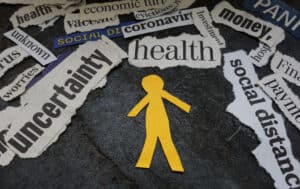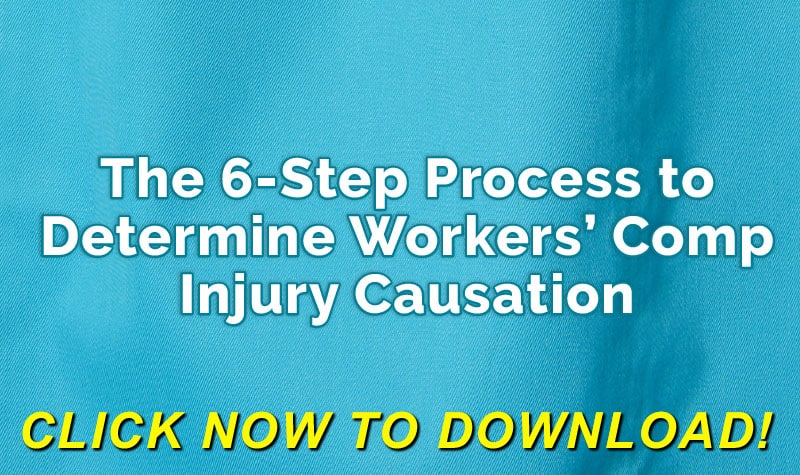
COVID-19: A Brief Review
The COVID-19 pandemic started to impact countries across the globe in early 2020 and soon led to lockdowns worldwide. While many employees were forced to work from home, countless people in the United States remained on the front lines. Initial claims for COVID-19 exposure in the workplace were denied as the condition was deemed an “ordinary disease of life.” However, as the disease spread, many state legislatures amended their workers’ compensation acts to include the following:
- Rebuttable statutory presumptions of workplace exposure for police officers, firefighters, doctors, health care professionals, and other “front line” workers; and
Click Link to Access Free PDF Download
“The 6-Step Process To Determine Workers’ Comp Injury Causation”
- Statutory frameworks that allowed employees not covered by these presumptions to make claims related to documented COVID-19 exposures that arose out of and were in the course of employment.
Many of these statutory presumptions have since expired. Employees are generally still allowed to claim COVID-19 exposure and illness, but they carry the ultimate burden of proof.
What is Long COVID?
Health and medical professionals worldwide are approaching a consensus of symptoms and conditions associated with post-acute sequelae of SARS-CoV-2 infection (LONG COVID), generically referred to as “long COVID.” This includes the development of an ICD-10 code used to signify the diagnosis of LONG COVID. General symptoms associated with this condition include:
- Insomnia;
- Changes in smell and taste;
- Shortness of breath;
- Chest pain;
- Palpitations;
- Dizziness:
- Depression; and
- Anxiety
It is also reported that individuals suffering from these symptoms describe their condition as disabling to the point where effortless tasks such as emptying a garbage can lead to exhaustion.
Dealing with Long Covid in Work Comp
A recent Workers Compensation Research Institute survey indicated the following characteristics of long covid workers’ compensation claims:
- Long Covid comprises about 6% of all COVID-related workers’ compensation claims;
- The average injured employee suffers from effects for about 18 months; and
- Medical bills associated with care average $29,000 per claim.
Based on these results, claim team members must pay attention to their files related to COVID-19/Long Covid and take proactive steps to ensure the employee receives the medical care and treatment they need. The problem arises when it comes to future medical care. Little is known about Long Covid and how to treat it in an effective manner.
In the meantime, members of the claim management team can take the following steps to be aggressive on these claims but still offer the dignity and respect any injured employee deserves:
- Foster an environment of responsiveness: Return all voicemail and email messages promptly. Remember that people suffering from LONG COVID feel isolated and alone. Never be judgmental – continue to express sympathy and support.
- Coordinate efforts with medical and legal experts: Claim handlers should roundtable LONG COVID claims regularly. Involve a medical director and utilization review tools to ensure all recommended care is moving the employee toward the goal of full recovery. Use existing treatment parameters regarding recommended CT scans, x-rays and other diagnostic tools as a basis for approving or denying care. Do not send the employee to a needless independent medical examination.
- Explore Return to Work Options: The goal of every claim should be to get the employee back to work This will improve their self-esteem and confidence. It will also prevent the progression of any psychological and/or psychiatric conditions to develop.
Do not excessively use surveillance tools. Use should be based on evidence of malingering only.
Conclusions
Unfortunately, COVID-19 is here to stay and will be a part of the workers’ compensation landscape for quite some time. Proactive members of the claim management team should use empathy when dealing with complex claims involving LONG COVID. They can also use other tools to navigate these claims best to avoid cost overruns within their claim programs. Use of common sense is a must.

Contact: mstack@reduceyourworkerscomp.com.
Workers’ Comp Roundup Blog: http://blog.reduceyourworkerscomp.com/
©2023 Amaxx LLC. All rights reserved under International Copyright Law.
Do not use this information without independent verification. All state laws vary. You should consult with your insurance broker, attorney, or qualified professional.













 Using a Workers Compensation Claim Coordinator
Using a Workers Compensation Claim Coordinator
